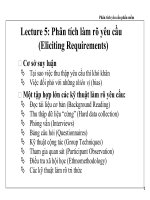Lecture 5 : Inflation
Bạn đang xem bản rút gọn của tài liệu. Xem và tải ngay bản đầy đủ của tài liệu tại đây (3.34 MB, 28 trang )
Lecture 5. Inflation
Dr.Do Xuan Luan
Faculty of economics and rural development (FERD), Thai Nguyen
University of Agriculture and Forestry (TUAF)
All lectures of the course
1. Introduction to macroeconomics;
2. Gross Domestic Product (GDP);
3. Economic growth;
4. Unemployment
5. Inflation;
6. Aggregate Demand & Aggregate Supply (AS-AD model);
7. Fiscal Policy;
8. Monetary Policy;
9. Combined effects of monetary and fiscal policy;
10. Trading with the world;
Contents
1
Definition of inflation
2
Methods of measuring inflation
3
Causes and effects of inflation
4
How to control inflation?
Definition of inflation
• Inflation is a process in which the
average level of prices rises and the
value of money falls.
• Notes:
money is losing value
not prices of all goods and services increase, but
the average price rises.
some price changes are more important than
others
the inflation rate and the price level: the
inflation rate is the percentage change in the
price level.
Measuring inflation
• In comparison to the previous year
𝑃𝑡 − 𝑃𝑡−1
𝐼𝑛𝑓𝑙𝑎𝑡𝑖𝑜𝑛 𝑟𝑎𝑡𝑒 =
𝑃𝑡−1
• In comparison to the base year
𝑃𝑡 − 𝑃0
𝐼𝑛𝑓𝑙𝑎𝑡𝑖𝑜𝑛 𝑟𝑎𝑡𝑒 =
𝑃0
• Average for a period of time
𝑛
𝑡=1 𝐼𝑛𝑓𝑙𝑎𝑡𝑖𝑜𝑛𝑡
𝐼𝑛𝑓𝑙𝑎𝑖𝑜𝑛 𝑟𝑎𝑡𝑒 =
𝑛−1
Where:
𝑃𝑡 : 𝑝𝑟𝑖𝑐𝑒 𝑖𝑛𝑑𝑒𝑥 𝑜𝑓 𝑡ℎ𝑒 𝑐𝑢𝑟𝑟𝑒𝑛𝑡 𝑦𝑒𝑎𝑟 𝑡
𝑃𝑡−1 : 𝑝𝑟𝑖𝑐𝑒 𝑖𝑛𝑑𝑒𝑥 𝑜𝑓 𝑡ℎ𝑒 𝑝𝑟𝑒𝑣𝑖𝑜𝑢𝑠 𝑦𝑒𝑎𝑟 (𝑡 − 1)
𝑃0 : price index of the base year
n: number of years
An example of inflation measurement
𝑃𝑡 − 𝑃𝑡−1
𝐼𝑛𝑓𝑙𝑎𝑡𝑖𝑜𝑛 𝑟𝑎𝑡𝑒 =
𝑃𝑡−1
• the price index in June 2015 was 218.0,
• and the price index in June 2014 was 215.7.
• Then, the inflation rate during the twelve months to June
2015 was
218.0−215.7
Inflation rate = 215.7 ∗
100 = 1.1%
• Interpretation: the price index in June 2015 increased by
1.1% compared to June 2014
• Question?: how price index is measured?
Price index measurement
Two common
methods
GDP deflator
GDP deflator
measures the
average level of
prices of all goods
and services that
make up GDP
The Consumer Price
Index (CPI)
is a price index
based on the
consumption
expenditures of a
basket of goods &
services..
The consumer price index (CPI)
• CPI is calculated as the ratio of the value of a basket in the
current period to its value in the base period (multiplied by
100)
• CPI=
•
𝐶𝑃𝐼 𝑡
𝐶𝑜𝑠𝑡 𝑜𝑓 𝐶𝑃𝐼 𝑏𝑎𝑠𝑘𝑒𝑡 𝑎𝑡 𝑐𝑢𝑟𝑟𝑒𝑛𝑡 𝑝𝑟𝑖𝑐𝑒𝑠
𝐶𝑜𝑠𝑡𝑠 𝑜𝑓 𝐶𝑃𝐼 𝑏𝑎𝑠𝑘𝑒𝑡 𝑎𝑡 𝑏𝑎𝑠𝑒𝑑−𝑝𝑒𝑟𝑖𝑜𝑑 𝑝𝑟𝑖𝑐𝑒𝑠
=
𝑝𝑖𝑡 𝑞𝑖0
𝑝𝑖0 𝑞𝑖0
× 100
×100
Of which:
• 𝑖 𝑖𝑠 𝑡ℎ𝑒 𝑐𝑜𝑚𝑚𝑜𝑑𝑖𝑡𝑦 𝑜𝑟 𝑠𝑒𝑟𝑣𝑖𝑐𝑒 𝑖
• 𝑞 𝑖𝑠 𝑡ℎ𝑒 𝑞𝑢𝑎𝑛𝑡𝑖𝑡𝑦 𝑎𝑛𝑑 𝑝 𝑖𝑠 𝑡ℎ𝑒 𝑝𝑟𝑖𝑐𝑒
• 𝑡: 𝑡ℎ𝑒 𝑦𝑒𝑎𝑟 𝑜𝑓 𝑖𝑛𝑡𝑒𝑟𝑒𝑠𝑡, 0: 𝑡ℎ𝑒 𝑏𝑎𝑠𝑒 𝑦𝑒𝑎𝑟
• CPI tells us a percentage increase in the average price level of
all commodities and services in the basket.
• Inflation rate =
CPIt −CPIt−1
CPIt−1
A basket of goods: an example
Fish
Rice
A typical basket of goods & services should represent
common choices of a majority of households
An example of calculating CPI and inflation rate
Suppose that a basket of final good s and services has two goods
namely rice and fish (10 kg of rice and 5 kg of fish)
Year
Price of
rice(1000
đ/kg)
Price of fish
Expenditure
(1.000
(1000 đ)
đ/kg)
2013
10
15
2014
12
2015
15
CPI
Inflation
rate %
?a
?d
?g
23
?b
?e
?h
30
?c
?f
?k
Calculate expenditure and inflation rates (the base year: 2013).
Make interpretation of results.
CPI might not capture
Does the consumer price index measure the cost of living?
Does a 5 percent increase in the CPI mean that the cost of
living has increased by 5 percent?
Substitution effects: prices of other goods and
consumers’ tastes
Arrival and disappearance of goods
Quality improvements
A typical of a basket of goods & services in Vietnam
Groups of goods and services
Weight (%)
Total expenditure on final goods and services
100,00
1. Food
39,93
2. Drink and cigarettes
4,03
3. Clothes
7,28
4. Housing, electricity, water, fuels &
10,01
constructional materials
5. Equipment & housewares
8,65
6. Medicines and healthcare services
5,61
7. Transportation services
8,87
8. Telecommunication
2,73
9. Education
5,72
9. Entertainment
3,83
10. Others
3,34
Using GDP deflator to measure price index
• GDP Deflator is the ratio of the value of aggregate final output at
current market prices (Nominal GDP) to its value at the base year
prices (Real GDP).
• 𝐺𝐷𝑃𝐷 =
𝐺𝐷𝑃𝑛
𝐺𝐷𝑃𝑟
∗ 100
• The GDP deflator is a price index telling us the average price change
of the whole economy
• GDP deflator =
qti pti
qti p0i
• Of which: i is the commodity or service i
• q is the quantity and p is the price
• t: the year of interest, 0: the base year
• D-GDP tells us a percentage increase in the average price level of the
whole economy . Example
GDP deflator: an example
Suppose, we have data of real and nominal GDP of
Vietnam
• 𝐺𝐷𝑃𝑟 2015 =
𝑘
1 𝑃2000
∗ 𝑄2015 = 64.64 billion US
• 𝐺𝐷𝑃𝑛 2015 =
𝑘
1 𝑃2015
∗ 𝑄2015 =193.60 billion US
• 𝐺𝐷𝑃𝐷 =
𝐺𝐷𝑃𝑛
𝐺𝐷𝑃𝑟
∗ 100=
193.60
∗
64.64
100= 299.50
Interpretation: the average price level in the economy
increased by 199.5% percent from 2000 (the base period for
estimating real GDP) to 2015.
GDP deflator & inflation: an exercise
• Assume that an economy produces two final goods
including rice and fish sauce. Price and quantity of each
good is provided as follows:
Rice
Year
Fish sauce
Price
Quantity
Price
Quantity
(1000d/kg)
(kg)
(1000đ/l)
(liters)
2013
10
1.000
8
2014
12
1.200
2015
15
1.350
Indicator
GDPn
GDPr
180
?
?
?
-
10
190
?
?
?
?
12
210
?
?
?
?
Calculate real, nominal GDP, GDP deflator and inflation rate (the
base year: 2013). Make interpretation of results.
DGDP Inflation
CPI vs. GDP deflator
Difference CPI
points
GDP deflator
1
includes anything bought by includes only domestic
consumers including foreign goods and not anything
goods
that is imported.
2
is a measure of only goods
bought by consumers
is a measure of the prices
of all goods and services
3
Commonly used to measure
inflation
Less common to measure
inflation
Causes of inflation
An increase in aggregate demanddemand pull inflation
(money supply, government purchases)
a decrease in aggregate supply –
Stagflation
(wage rates+, prices of raw materials+)
Inflation over the business cycle
(the Phillips Curve)
Inflation
Causes of inflation: Demand pull inflation
Price index
(CPI, GDP
deflator)
AS0
Inflation
Demand+:
C+
I+
G+
X+
IM-
P1
P0
AD1
AD0
Qa ∆Y Qp
Value of quantities
of final goods and
services
Causes of inflation:
A decrease in aggregate supply – stagflation Inflation
AS1
Price
index
AS0
Inflation
AS(-):
P1
P0
AD0
Qa ∆Y Qp
Prices of
materials(+)
Wage (+)
Rent (+)
Interest rate
(+)
Technology(-)
Weather (-)
Value of quantities of
final goods and services
Causes of inflation:
cycles tend to change cyclically
BusinessBusiness
cycle: inflation
over time
Causes of business
cycles:
Inflation
high
Inflation
rise
Inflation low
• Economic
Disturbances (i.e:
war);
• Economic
policies (i.e:
interest rate…);
• Supply shocks
(i.e: flood,
drought,
earthquake…);
Effects of inflation on redistribution of income and wealth
• Debtors gain and Creditors lose. Why?
Price (+) Money(-) Goods and services (-)
• Salaried Persons (white collar persons) lose. Why?
Salaries are slow to adjust when prices are rising.
• Wage Earners may gain or lose. Why?
• Depending upon the speed with which their wages adjust to rising
prices.
• And also depends on their unions’ power.
• Fixed Income Group loses. Why?
• The recipients of transfer payments such as pensions,
unemployment insurance, social security, etc. and recipients of
interest and rent live on fixed incomes.
Effects of inflation on redistribution of income
and wealth
• Equity Holders or Investors
Persons who hold shares or stocks of companies gain during inflation. Why?
Price (+) Business activities (+) Profits (+) Dividends (+).
• But those who invest in debentures, securities, bonds, etc. which carry a
fixed interest rate lose during inflation because they receive a fixed sum
while the purchasing power is falling.
• Businessmen of all types (producers, traders and real estate holders) gain
during periods of rising prices.
Price (+) Business activities (+) Profits (+)
Effects of inflation on redistribution of
income and wealth
• Agriculturists:
• Landlords lose during rising prices because they get fixed rents.
• Peasant proprietors who own and cultivate their farms gain.
Prices of farm products increase more than the cost of
production.
• The landless agricultural workers are hit hard by rising prices.
Their wages are not raised by the farm owners, because trade
unionism is absent among them.
Effects of inflation on savings and
investment
• Less saving: High rate of inflation will have an adverse effect
on the savings in the economy. Why?
• As people spend more to sustain their present standard of living, less
is being saved.
• This will result in less loanable funds being available to firms for
investment.
• Inflation tends to discourage investment and long term
economic growth. Why?
• The uncertainty and confusion are more likely to occur during periods
of high inflation.
• High inflation is said to discourage stability and discourage firms to
take risks and invest.
Conclusion on effects of inflation
Title
Add your text
Thus inflation
redistributes
income from wage
earners and fixed
income groups to
profit recipients,
and from creditors
to debtors.
The very poor
and the very rich
are more likely
to lose than
middle income
groups.









